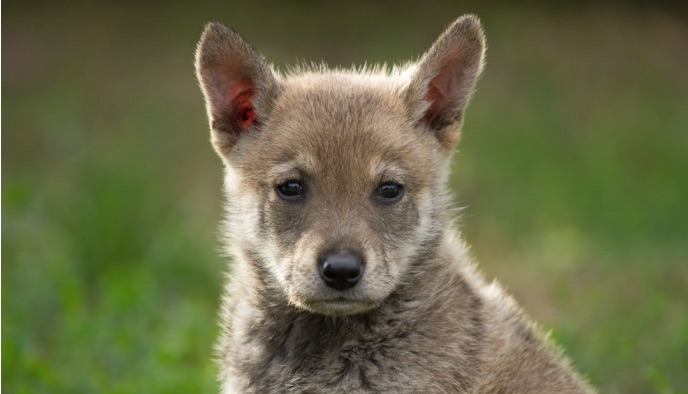By Andre Butzberger
On a recent Friday afternoon in March, Chooli, F891, one of the female wolves at the Southwest Wildlife Conservation Center, initiated a low solo call that was echoed by her mate, Ghost, M877. Soon, the nearby wolves joined in as a pack for 30 seconds of chilling howls. Visitors ran to the fences with held breaths and cameras to capture the rare experience.
The center, which cares for 13 Mexican gray wolves (a part of the captive population), is one of the few places in Arizona where visitors can witness this once-in-a-lifetime occurrence. (Another opportunity takes place on April 15, at Dinner with Wolves, a fundraiser set just a few feet from these intriguing animals.)
Wolves are not the villain
Kim Carr hears the call of the not-so-wild wolves regularly. The animal care manager enters the enclosures everyday to feed and tend to the wolves. “I absolutely love them,” said Carr. “They’re one of my favorite animals to care for.”
But they aren’t on everyone’s good side. “In every childhood story, the wolf is the bad guy,” said Nikki Julien, director of education for the Southwest Wildlife Conservation Center.
She may be right. As many remember, the “big bad wolf” has been blowing down houses, messing with Peter, and terrorizing grandmothers in fairy tales for generations, so it’s no wonder they get a bad rep. But do they really deserve it?
“I think they are very misunderstood,” Julien said.

Little Red Riding Hood might disagree, but “they really are the heroes of our ecosystem,” said Julien. “They keep deer and elk in check.” And that’s a good thing, because the overpopulation of deer has contributed to the loss or decline of certain plant and tree life as well as several songbird species.
The war against the wolf
Thousands of Mexican gray wolves once dominated the Southwest, roaming Arizona, New Mexico and Mexico. Then, a private initiative that later became a federal program began an eradication campaign against all wolves in order to protect livestock. Part of the plan included denning, a process of pulling wolf pups from their den and killing them. The campaign also used poisoned animal carcasses to lure the wolves as well. This approach killed the wolves, and more. Eagles, ravens, foxes, bears, and other animals were eliminated as well. By the 1970s, the wolves were practically extinct. That’s when the U.S. Fish and Wildlife Service began a species survival plan to grow the population. The program included a captive breeding plan with the seven remaining wolves. Today, there are about 235 gray wolves in captivity and 113 in the wild population.
After they are beyond their breeding years, many are placed in zoos. As they grow old, they retire from these sometimes stressful and highly visited habitats to find permanent homes in U.S.D.A. approved facilities like the Southwest Wildlife Conservation Center. The center is a final part of the Mexican Wolf Species Survival Plan.
“It’s the Sun City West for the wolf world,” joked Julien.
The gray wolves at the Scottsdale sanctuary continue in what is considered a very sophisticated social structure with a leader (alpha) and mate. (In the wild, the alpha usually leads the pack and is the first to eat.)

The wolves are paired up and placed in enclosures where they run around bushes, water, and each other. One of the most endearing quality of wolves is their romantic relationships. When Chooli was put in with Ghost, Julien said it was “love at first sight.” Another wolf has had all three of her mates die while on the property, and the team has dubbed her the “Black Widow” of the wolves. The youngest wolf, Cinderella F1219, brings out the feistiness in her male counterparts.
The devoted wolf
During their lives, wolves will find a mate and remain loyal to them until a death or separation. When this happens, the wolf often lets out a mournful howl. The Southwest Conservation Center staff recently experienced this when Chooli was taken from her mate, Ghost, for a two-day operation. “He would make this mournful sound every few minutes,” recalled Julien. After the operation, the two mates were happily reunited and will continue to live out the rest of their wolf years at the conservation center.
The 10-acre Southwest Wildlife Conservation Center was started by Linda Searles in 1994, after she nursed an orphaned coyote pup named Don Coyote. The coyote’s family had been accidentally hurt by a tractor. It was then that Searles discovered the need for a center such as hers.
“Wild animals that were harmed or injured had no place to go,” Searles said.
Since then, thousands of animals, including bears, raccoons, bobcats, coyotes, mountain lions and even hybrid mixes have been rescued and cared for. The center has grown and so has its operating budget, which has reached $1 million yearly. To support their work, the animal rehab center hosts the annual Dinner with Wolves fundraiser, which is limited to just 100 guests.
“The goal of the evening is to raise money for the wolves and other animals,” she said.
Andre Butzberger is a junior at Chaparral High School in Scottsdale. He loves writing, theater, track, baseball, actor Benedict Cumberbatch and his girlfriend, Faith Cain.







With your post, your readers, particularly those beginners who are trying to explore this field won’t leave your page empty-handed. Here is mine at Webemail24 I am sure you’ll gain some useful information about Door and Window Services too.
Great Article and so informative. I am interested in the wolves at Yellowstone that roam around wild. They do have an enclosure where you can see them. The bears at Yellowstone are very well controlled and if seen during the rangers come to protect them and you.
Wonderful insightful article! Congrats to the writer. I have a much better understanding on the need for places to care for these beautiful animals.